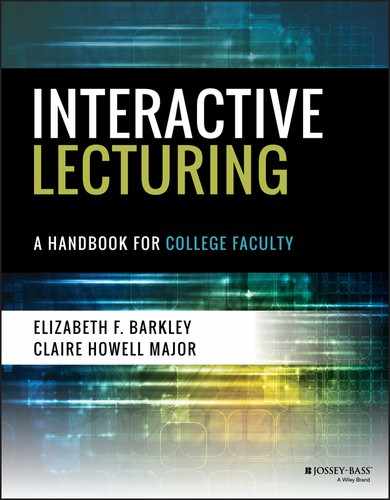ENGAGING LECTURE TIP 32
Meet and Greet
Have you ever gone to a lecture where the speaker is at the front of the room looking very busy and certainly aloof? Or, have you gone to a lecture in which the speaker met you at the door or walked around the room talking with members of the audience? If so, which approach do you prefer? Most students probably prefer the second. A Meet and Greet, in which you briefly speak with students before the formal class session begins, can be a very good way to begin each lecture session.
Meet and Greet is important because it sets the tone for the class. Greeting the students signals that you care about them and are interested in getting to know them, which tends to improve student perception of not only you but also your teaching. By meeting students before the lecture begins, you may learn about the students and thus can target information to the particular group, or you may get information from them that can somehow help you during the lecture.
Some ideas for the Meet and Greet are as follows:
- The handshake. If your class size allows it, meeting students at the door and shaking hands can make a strong connection with them.
- The “name, please.” If you are trying to match names and faces, ask students to say their names as they enter the classroom.
- The “hey, I know you.” If you want students to know that you have been paying attention, make a comment when they enter the room that shows that you know who they are. For example, “got your e-mail and sent you a response” or “hope the game went well last night” or “nice! A new laptop!” Some signal that you are making connections can help students to feel recognized and valued.
- The small talk. If you want to seem like a real person to students, you can simply engage them in some small talk. You might chat about the weather, an upcoming movie or sporting event, or a topic in the news.
- The entry ticket. If you want to check student understanding or completion of reading assignments, assign a question before class and ask students to bring their responses with them to class on an index card, being sure to include their names and the date. This is also a quick way to check roll. (See “Entry and Exit Tickets” in Barkley and Major, 2016, pp. 91–95, for additional guidance on using this technique to promote and assess learning.)
- The handout. As students enter the room, provide them with a handout for the session. (See Tips in Chapter 8 for ideas for good handouts.) This signals that you have important content and that you intend to get down to business immediately and not waste any class time.
Example
Key References and Resources
- Barkley, E. F., & Major, C. H. (2016). Learning assessment techniques: A handbook for college faculty. San Francisco, CA: Jossey-Bass.
- Ford, N., McCullough, M., & Schutta, N. T. (2012). Presentation patterns: Techniques for crafting better presentations. Boston, MA: Addison Wesley.
- Lemov, D. (2010). Teach like a champion: 49 strategies that put students on the path to success. San Francisco, CA: Jossey-Bass.
